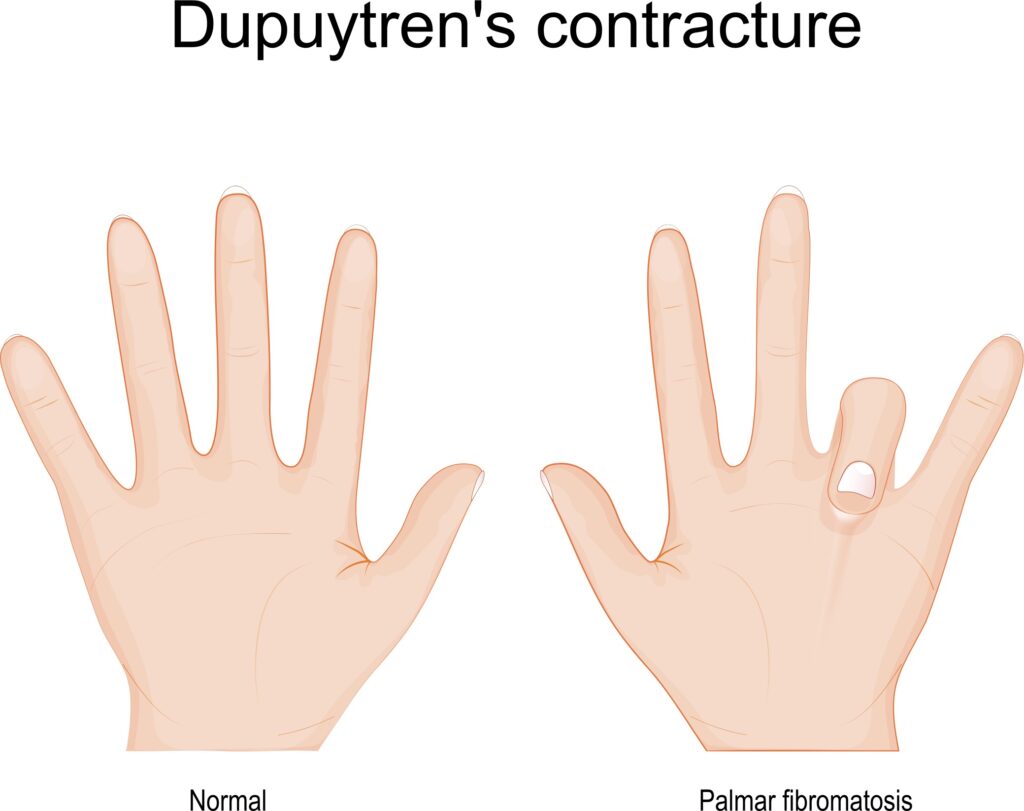What Happens During Early Stage Dupuytren’s Contracture
Have you ever imagined yourself in a situation where the only thing your hand feels is pain? The layers of skin and tissue in your hand grows tighter and tighter with each week, a finger or two is bent out of proportion, and at the moment, all you know is unbearable discomfort.
How to Treat Dupuytren’s Contracture in the Early Stages
Have you ever imagined yourself in a situation where the only thing your hand feels is pain? The layers of skin and tissue in your hand grows tighter and tighter with each week, a finger or two is bent out of proportion, and at the moment, all you know is unbearable discomfort.
This condition is known as Dupuytren’s Contracture.
What exactly is Dupuytren’s Contracture?
To put things in a more descriptive manner, the term “contracture” is a nasty process that affects your hand whereby the skin and tissue form a layer of knots under the palm. This can take years to build up and eventually leads to a thick cord being formed that causes a finger or two to be bent uncomfortably.
The bend in the fingers may not be reversible, and it is usually the fingers furthest away from the thumb that are prone to shape changes. This makes it difficult to grasp items and use the hand in ways that most people take for granted. Stiffness and the loss of flexibility worsen over time as the palm thickens and tightens. This condition generally grows worse over time. There is no cure, so taking preventative measures and trying to comfort the knots in the hand is the best solution.
Given the high cost of medical care, it’s hardly a shock that patients are drowning in medical debt. Almost 20% of American households have delinquent medical bills that affect their credit report, according to NBC News. Having medical bills in collections makes it more difficult for patients to engage in other economic activities, such as purchasing a home or securing a loan to start a business.
There are a few options for non-surgical treatments for Dupuytren’s Contracture but a extremely invasive surgery is commonplace for sufferes.
What are the warning signs?
- It is often mistaken for a callus.
- There is a burning and itching sensation in the tender part of the palm.
- The affected area looks like a bruise healing.
- Hard lumps in the form of nodules are formed.
Factors that increase the risk
- It is more likely to affect men rather than women.
- Dupuytren’s contracture is more likely to affect people with ages 50 and above.
- Genetics and family history play a large factor.
- It has been researched that people who smoke and drink are more likely to contract the disease.
- Further research shows that diabetes increases the chances of being affected by the disease.
How to treat in early stages
Needling
As painful as it sounds, this non-surgical treatment for Dupuytren’s contracture is very effective. The needle is pushed into the skin to rupture and break the cord of tissue that moves the finger. The shortening and hardening of the tissue may occur again, but this technique can be repeated.
It cannot be done on all areas of the finger, as damage may be done to a nerve or a tendon. There is also no need for a cut on the finger. At the end of the process, there is a very little need to exercise the fingers.
Enzyme injections
This process is done with a certain type of enzyme being injected into the taut cord of the palm to ease and incapacitate it, so that it can later be operated on by a doctor. The doctor would later be able to easily align the fingers. An enzyme that has been accepted by the FDA to use in this circumstance is the collagenase clostridium histolyticum, also known as xiaflex. This technique has the same advantages and disadvantages as the needling method.
Heat, Ultrasound and Splinting
There are several options on the market for tools offering ultrasound, heat and stretching. The most commonly used device is the Dupuytren’s Wand. The stretch is typically controlled by an elastic tape “splint” offering a strong recoiling effect to encourage the finger to remain in a straightened position. Unlike a normal splint, Dupuytren’s Tape allows the user to grasp objects normal as it does not restrict the closing of the hand.
Surgery
Surgery is the preferred method of treatment for those in a later stage of disease. If the fingers have extremely restricted functioning, the affected tissue in the palm would be removed. The problem with this method is that recovery after surgery takes longer and exercise of the fingers would be required. It has a more conclusive and lasting effect compared to the other methods. In addition, surgery does not guarantee non-reoccurrence.
Finally!
Dupuytren’s contracture is a nasty bit of work that can prove to be more than painful. It is a tough condition that can affect a person’s day to day activities, which is why it is so important to be educated on the topic. The whole idea is to gain awareness, look for the signs, and to act quickly in order to prevent or delay potential problems in the future.
What Happens During Early Stage Dupuytren’s Contracture?
Some people find it challenging to extend their fingers or open their palms fully. This is because their hands have developed Dupuytren’s contracture, which can significantly affect daily life if not caught early. Here’s what you need to know about early stage Dupuytren’s contracture symptoms and what you can do about them.
What is Dupuytren’s Contracture?
Dupuytren’s contracture, also known as Dupuytren’s disease, is a benign condition that mainly affects the ring and pinky fingers, making them bend towards the palm. This disease is more common among older males and individuals struggling with alcoholism and other medical conditions like epilepsy and diabetes.
Dupuytren’s disease occurs when painless nodules develop in the fibrous tissue under the skin of the palm. As the condition progresses, the nodules develop into fibrous cords. These cords usually radiate out to the middle and small finger, preventing you from straightening them.
In advanced stages, the disease permanently deforms the hand, affecting your quality of life. However, in many instances, Dupuytren’s contracture doesn’t progress this far, instead stabilising or even regressing.
Regardless, it’s advisable to note the early symptoms so that you can seek medical intervention in time.
Symptoms of Early Stage Dupuytren’s Contracture
This condition develops over decades, meaning it could take years to realise your hand is affected. In addition, individuals with Dupuytren’s disease rarely feel pain in the affected hand. As such, it might be too late by the time your hand shows physical signs.
Therefore, it’s essential to identify other symptoms to prevent permanent finger contraction. In addition, timely recognition of signs of early stage Dupuytren’s contracture allows your doctor to rule out other hand-deforming conditions like trigger finger.
The condition progresses through three phases, with the first two involving nodule formation and the last resulting in long-lasting contraction of the pinky and middle fingers.
Here’s what happens during early stage Dupuytren’s contracture:
- First, the tissue under the skin of the palm develops small nodules in the condition’s proliferative phase.
- At this point, you most likely won’t feel any pain in or around the lumps. However, some people feel tenderness and itchiness in the affected palm areas.
- The lumps become harder and more pronounced.
In many instances, the hard nodules stabilise and remain unchanged for years. However, in some rarer situations, the lumps regress.
Regardless, you should consult your doctor if you feel lumps developing under the skin in your palm.
Treating Early Stage Dupuytren’s Contracture
Treating this condition in the early stages could include:
- Corticosteroid injections into the nodules of individuals with painful lumps
- Collagenase (enzyme) injections into the nodules to dissolve the lumps
- Physical and occupational therapy involving heat and ultrasonic waves helps with the lumps
- Using a splint or brace to increase the fingers’ range of motion to prevent them from contracting towards the palm
In instances where the lumps have just started developing into cords, your doctor can use a needle to break up these rope-like structures before they can cause significant contracture.
When the disease progresses to significant bending of the fingers, your doctor may recommend surgery to release the cords.






